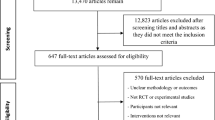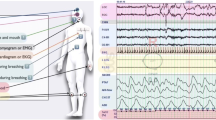Abstract
We determined the prevalence of concomitant sleep disorders in patients with a primary diagnosis of obstructive sleep apnea (OSA). We retrospectively analyzed 643 patients, aged ≥18, with a primary diagnosis of OSA, evaluated by sleep specialists, in whom clinical and polysomnographic data were derived using standardized techniques by reviewing data from a standardized database and clinical charts. Concomitant sleep disorders were listed according to the International Classification of Sleep Disorders (American Academy of Sleep Medicine, 2000). The mean age was 48.5±13.5 years and 55% were male. Racial distributions were African–Americans 51.8% and Caucasian 47%. Indices of disordered breathing were respiratory disturbance index 32.4±30.4/h sleep and time <90% O2 saturation 44.5±81.6 min. Thirty-one percent of patients had a concomitant sleep disorder. The most common were inadequate sleep hygiene (14.5%) and periodic limb movement disorder (PLMD, 8.1%). Of patients with other sleep disorders, 66.8% had treatment initiated for these disorders. Predictors of inadequate sleep hygiene (logistic regression) were: age (each decade OR=0.678, P=0.000000), gender (for M, OR=0.536), and the presence of at least one other major system disorder (OR=2.123, P=0.0015). Predictors of PLMD were: age (each decade OR=0.794, P=0.0005), gender (for M, OR=0.433, P=0.004), and total sleep time (for each 10 min, OR=0.972, P=0.0013). We conclude that approximately one third of patients with sleep apnea have another identifiable sleep disorder, usually requiring treatment. This suggests that practitioners evaluating and treating sleep apnea ought to be prepared to deal with other sleep disorders as well.
Similar content being viewed by others
References
Netzer NC, Stoohs RA, Netzer CM, Clark K, Strohl KP (1999) Using the Berlin questionnaire to identify patients at risk for the sleep apnea syndrome. Ann Intern Med 131:485–491
Haponik EF, Frye AW, Richards B, Wymer A, Hinds A, Pearce K, McCall V, Konen J (1996) Sleep history is neglected diagnostic information: challenges for primary care physicians. J Gen Intern Med 11:759–761
Chung SA, Jairam S, Hussain MR, Shapiro CM (2001) Knowledge of sleep apnea in a sample grouping of primary care physicians. Sleep Breath 5:115–121
BaHammam AS (2000) Knowledge and attitude of primary health care physicians towards sleep disorders. Saudi Med J 21:1164–1167
Rosen RC, Rosekind M, Rosevear C, Cole WE, Dement WC (1993) Physician education in sleep and sleep disorders: a national survey of U.S. medical schools. Sleep 16:249–254
Young T, Peppard P, Gottlieb D (2002) Epidemiology of obstructive sleep apnea: a population health perspective. Am J Respir Crit Care Med 165:1217–1239
Bassiri A, Guilleminault C (2000) Clinical features and evaluation of obstructive sleep apnea-hypopnea syndrome. In: Kryger M, Roth T, Dement W (eds) Principles and practice of sleep medicine, 3rd edn. WN Saunders, Philadelphia, pp 869–878
Nieto FJ, Young TB, Lind BK, Shahar E, Samet JM, Redline S, D’Agostino RB, Newman AB, Lebowitz MD, Pickering TG (2000) Association of sleep-disordered breathing, sleep apnea, and hypertension in a large community-based study: sleep heart health study. JAMA 283:1829–1836
Jenkinson C, Davies RJ, Mullins R, Stradling JR (1999) Comparison of therapeutic and subtherapeutic nasal continuous positive airway pressure for obstructive sleep apnoea: a randomized prospective parallel trial. Lancet 353:2100–2105
Young T, Palta M, Dempsey J, Skatrud J, Weber S, Badr S (1993) The occurrence of sleep-disordered breathing among middle-aged adults. N Engl J Med 328(17):1203–1235
American Academy of Sleep Medicine (2000) ICSD—international classification of sleep disorders, revised: diagnostic and coding manual. American Academy of Sleep Medicine
Scharf SM, DeMore J, Landau T, Smale P (2004) Comparison of primary care practitioners and sleep specialists in the treatment of obstructive sleep apnea. Sleep Breath 8:111–124
Exar EN, Collop NA (2001) The association of upper airway resistance with periodic limb movements. Sleep 24:188–192
Carelli G, Krieger J, Calvi-Gries F, Macher JP (1999) Periodic limb movements and obstructive sleep apneas before and after continuous positive airway pressure treatment. J Sleep Res 8:211–216
Baran AS, Richert AC, Douglass AB, May W, Ansarin K (2003) Change in periodic limb movement index during treatment of obstructive sleep apnea with continuous positive airway pressure. Sleep 26:717–720
Chesson AL Jr, Ferber RA, Fry JM, Grigg-Damberger M, Hartse KM, Hurwitz TD, Johnson S, Kader GA, Littner M, Rosen G, Sangal RB, Schmidt-Nowara W, Sher A (1997) The indications for polysomnography and related procedures. Sleep 20:423–427
Carskadan MA, Rechtschaffen A (2000) Monitoring and staging human sleep. In: Kryger M, Roth T, Dement W (eds) Principles and practice of sleep medicine, 3rd edn. Saunders, Philadelphia, pp 1197–1215
Rechtshaffen A, Kales A (eds) (1968) A manual of standardized terminology: techniques and scoring system for sleep stages of human subjects. US Department of Health, Education and Welfare, Public Health Service–National Institutes of Health. Neurological Information Network. Bethesda, Maryland
Silber MH, Krahn LE, Olson EF, Pankratz S (2002) The epidemiology of narcolepsy in Olmsted County, Minnesota: a population-based study. Sleep 25:197–202
Hublin C, Partinen M, Kaprio J, Koskenvuo M, Guilleminault C (1994) Epidemiology of narcolepsy. Sleep 17(8 Suppl):S7–S12
Punjabi NM, Welch D, Strohl KP (2000) Sleep disorders in regional sleep centers: a national cooperative study. Sleep 23:471–480
Shneerson J, Wright J (2004) Lifestyle modification for obstructive sleep apnoea (Cochrane Review). In: The Cochrane library, vol 3. Wiley, Chichester, UK, pp 1–7
Mendelson WB (1997) Experiences of a sleep disorders center: 1,700 patients later. Clevel Clin J Med 64:46–51
Redline S, Adams N, Strauss ME, Roebuck T, Winters M, Rosenberg C (1998) Improvement of mild sleep-disordered breathing with CPAP compared with conservative therapy. Am J Respir Crit Care Med 157:858–865
Scharf SM, Seiden L, DeMore J, Carter-Pokras O (2004) Racial differences in clinical presentation of patients with sleep disordered breathing. Sleep Breath 8:173–183
App WE, Boatwright GW, Ostrander SE, Unruh MM, Winslow DH (1990) Disorders of excessive daytime somnolence: a case series of 1,000 patients. J Ky Med Assoc 88:393–396
Ohayon MM, Roth T (2002) Prevalence of restless legs syndrome and periodic movement disorder in the general population. J Psychosom Res 53:547–554
Ancoli-Israel S, Kripke DF, Mason W, Kaplan OJ (1985) Sleep apnea and periodic movements in an aging sample. J Gerontol 40:419–425
Carelli G, Krieger J, Calvi-Gries F, Macher JP (1999) Periodic limb movements and obstructive sleep apnea before and after continuous positive airway pressure treatment. J Sleep Res 8:211–216
Baran AS, Richert AC, Bouglass AB, May W, Ansarin K (2003) Change in periodic limb movement index during treatment of obstructive sleep apnea with continuous positive airway pressure. Sleep 26:717–720
Coleman RM, Pollak CP, Weitzman ED (1978) Periodic movements in sleep (nocturnal myoclonus): relation to sleep disorders. Trans Am Neurol Ass 103:230–233
Fry JM, DiPhillipo MA, Pressman MR (1989) Periodic leg movements in sleep following treatment of obstructive sleep apnea with nasal continuous positive airway pressure. Chest 96:89–91
Author information
Authors and Affiliations
Corresponding author
Rights and permissions
About this article
Cite this article
Scharf, S.M., Tubman, A. & Smale, P. Prevalence of concomitant sleep disorders in patients with obstructive sleep apnea. Sleep Breath 9, 50–56 (2005). https://doi.org/10.1007/s11325-005-0014-1
Published:
Issue Date:
DOI: https://doi.org/10.1007/s11325-005-0014-1




